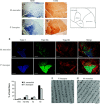Reduced mitochondrial ROS, enhanced antioxidant defense, and distinct age-related changes in oxidative damage in muscles of long-lived Peromyscus leucopus
- PMID: 23325454
- PMCID: PMC4116415
- DOI: 10.1152/ajpregu.00139.2012
Reduced mitochondrial ROS, enhanced antioxidant defense, and distinct age-related changes in oxidative damage in muscles of long-lived Peromyscus leucopus
Abstract
Comparing biological processes in closely related species with divergent life spans is a powerful approach to study mechanisms of aging. The oxidative stress hypothesis of aging predicts that longer-lived species would have lower reactive oxygen species (ROS) generation and/or an increased antioxidant capacity, resulting in reduced oxidative damage with age than in shorter-lived species. In this study, we measured ROS generation in the young adult animals of the long-lived white-footed mouse, Peromyscus leucopus (maximal life span potential, MLSP = 8 yr) and the common laboratory mouse, Mus musculus (C57BL/6J strain; MLSP = 3.5 yr). Consistent with the hypothesis, our results show that skeletal muscle mitochondria from adult P. leucopus produce less ROS (superoxide and hydrogen peroxide) compared with M. musculus. Additionally, P. leucopus has an increase in the activity of antioxidant enzymes superoxide dismutase 1, catalase, and glutathione peroxidase 1 at young age. P. leucopus compared with M. musculus display low levels of lipid peroxidation (isoprostanes) throughout life; however, P. leucopus although having elevated protein carbonyls at a young age, the accrual of protein oxidation with age is minimal in contrast to the linear increase in M. musculus. Altogether, the results from young animals are in agreement with the predictions of the oxidative stress hypothesis of aging with the exception of protein carbonyls. Nonetheless, the age-dependent increase in protein carbonyls is more pronounced in short-lived M. musculus, which supports enhanced protein homeostasis in long-lived P. leucopus.
Figures





Similar articles
-
Longevity is associated with increased vascular resistance to high glucose-induced oxidative stress and inflammatory gene expression in Peromyscus leucopus.Am J Physiol Heart Circ Physiol. 2009 Apr;296(4):H946-56. doi: 10.1152/ajpheart.00693.2008. Epub 2009 Jan 30. Am J Physiol Heart Circ Physiol. 2009. PMID: 19181967 Free PMC article.
-
Vascular superoxide and hydrogen peroxide production and oxidative stress resistance in two closely related rodent species with disparate longevity.Aging Cell. 2007 Dec;6(6):783-97. doi: 10.1111/j.1474-9726.2007.00339.x. Epub 2007 Oct 8. Aging Cell. 2007. PMID: 17925005
-
Biochemical correlates of longevity in two closely related rodent species.Biochem Biophys Res Commun. 1993 Oct 15;196(1):7-11. doi: 10.1006/bbrc.1993.2208. Biochem Biophys Res Commun. 1993. PMID: 8216337
-
Human skeletal muscle aging and the oxidative system: cellular events.Curr Aging Sci. 2008 Dec;1(3):182-91. doi: 10.2174/1874609810801030182. Curr Aging Sci. 2008. PMID: 20021391 Review.
-
Therapeutics against mitochondrial oxidative stress in animal models of aging.Ann N Y Acad Sci. 2002 Apr;959:330-40. doi: 10.1111/j.1749-6632.2002.tb02104.x. Ann N Y Acad Sci. 2002. PMID: 11976207 Review.
Cited by
-
Genomes, expression profiles, and diversity of mitochondria of the White-footed Deermouse Peromyscus leucopus, reservoir of Lyme disease and other zoonoses.Sci Rep. 2019 Nov 26;9(1):17618. doi: 10.1038/s41598-019-54389-3. Sci Rep. 2019. PMID: 31772306 Free PMC article.
-
Hematologic and serum biochemical values of 4 species of Peromyscus mice and their hybrids.J Am Assoc Lab Anim Sci. 2014 Jul;53(4):336-43. J Am Assoc Lab Anim Sci. 2014. PMID: 25199088 Free PMC article.
-
Protective Role of Short-Chain Fatty Acids against Ang- II-Induced Mitochondrial Dysfunction in Brain Endothelial Cells: A Potential Role of Heme Oxygenase 2.Antioxidants (Basel). 2023 Jan 10;12(1):160. doi: 10.3390/antiox12010160. Antioxidants (Basel). 2023. PMID: 36671022 Free PMC article.
-
Physiological Evidence for Delayed Age-related Hearing Loss in Two Long-lived Rodent Species (Peromyscus leucopus and P. californicus).J Assoc Res Otolaryngol. 2022 Oct;23(5):617-631. doi: 10.1007/s10162-022-00860-4. Epub 2022 Jul 26. J Assoc Res Otolaryngol. 2022. PMID: 35882705 Free PMC article.
-
Ranolazine promotes muscle differentiation and reduces oxidative stress in C2C12 skeletal muscle cells.Endocrine. 2017 Oct;58(1):33-45. doi: 10.1007/s12020-016-1181-5. Epub 2016 Dec 8. Endocrine. 2017. PMID: 27933435 Free PMC article.
References
-
- Abnous K, Storey KB. Skeletal muscle hexokinase: regulation in mammalian hibernation. Mol Cell Biochem 319: 41–50, 2008 - PubMed
-
- Akerman KE, Wikström MK. Safranine as a probe of the mitochondrial membrane potential. FEBS Lett 68: 191–197, 1976 - PubMed
-
- Anderson EJ, Neufer DP. Type II skeletal myofibers possess unique properties that potentiate mitochondrial H2O2 generation. Am J Physiol Cell Physiol 290: C844–C851, 2006 - PubMed
-
- Andziak B, O'Connor TP, Qi W, DeWaal EM, Pierce A, Chaudhuri AR, Van Remmen H, Buffenstein R. High oxidative damage levels in the longest-living rodent, the naked mole-rat. Aging Cell 5: 463–471, 2006 - PubMed
-
- Augustin H, Partridge L. Invertebrate models of age-related muscle degeneration. Biochim Biophys Acta 1790: 1084–1094, 2009 - PubMed
Publication types
MeSH terms
Substances
Grants and funding
LinkOut - more resources
Full Text Sources
Other Literature Sources
Medical

